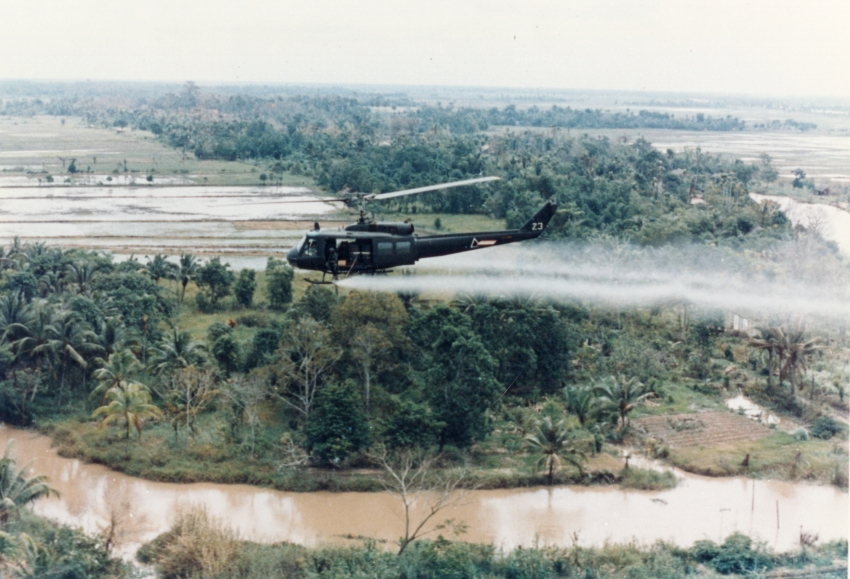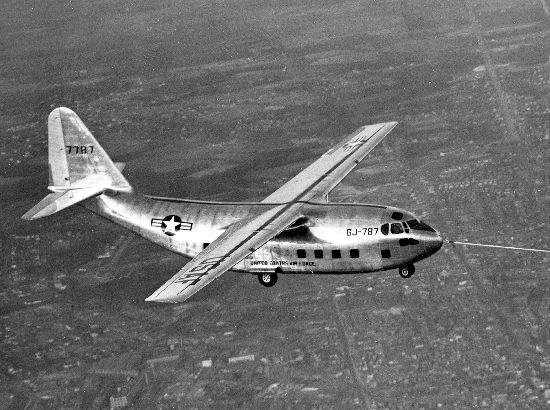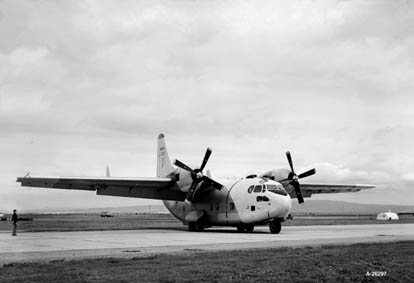|
C-123
The Fairchild C-123 Provider is an American military transport aircraft designed by Chase Aircraft and then built by Fairchild Aircraft for the U.S. Air Force. In addition to its USAF service, which included later service with the Air Force Reserve and the Air National Guard, it also went on to serve most notably with the U.S. Coast Guard and various air forces in Southeast Asia. During the War in Vietnam, the C-123 was used to deliver supplies, to evacuate the wounded, and also used to spray Agent Orange. Design and development The C-123 Provider was designed originally as an assault military glider, glider aircraft for the United States Air Force (USAF) by Chase Aircraft as the Chase XCG-20, XCG-20 (Chase designation MS-8 Avitruc)Gunston 1980a, p. 170. Two powered variants of the XCG-20 were developed during the early 1950s, as the XC-123 and Chase XC-123A, XC-123A. The only difference between the two was the type of engines used. The XC-123 used two Pratt & Whitney R-2800-2 ... [...More Info...] [...Related Items...] OR: [Wikipedia] [Google] [Baidu] |
Chase XC-123A
The Chase XC-123A was an experimental transport aircraft developed by Chase Aircraft. The first jet-powered transport built for the United States Air Force, it was intended for use as a high-speed transport for high-priority cargo and personnel. The XC-123A was determined to have insufficient advantages over existing types in service, and did not go into production. The sole prototype was converted into the piston-powered Stroukoff YC-123D to evaluate boundary layer control systems. Design and development In the late 1940s, Chase Aircraft had developed the XG-20, the largest glider ever built in the United States.Sergievsky et al. 1998, p.128 By the time it was ready for operations, however, U.S. military doctrine had been altered to remove the requirement for the use of transport gliders in combat.Mitchell 1992, p.164. However, the XG-20's aircraft had been designed to allow for the easy installation of power plants, and Chase modified the two prototypes into powered aircraft, ... [...More Info...] [...Related Items...] OR: [Wikipedia] [Google] [Baidu] |
Stroukoff YC-134
The Stroukoff YC-134, designed in 1956, was based heavily on the Fairchild C-123 Provider, itself designed by Michael Stroukoff. The United States military contracted with Stroukoff Aircraft Corporation to develop an improved version of the aircraft, combining features that the company had developed for the YC-123D and YC-123E. History Stroukoff's work with the C-123 In 1956, Stroukoff had already gained much experience working on the C-123 Provider, having completed two contracts based on that airframe. Its YC-123D had introduced a Boundary Layer Control (BLC) system to the C-123B. This system forced pressurized air over the upper wing surfaces of the airplane, making the wing work as if it were flying at much greater airspeed. This greatly improved landing and take-off performance, gross weight capability, and lowered the C-123's stall speed. The YC-123E had been another experiment in improving the C-123's ability to operate wherever it might need to, introducing Stroukoff' ... [...More Info...] [...Related Items...] OR: [Wikipedia] [Google] [Baidu] |
Agent Orange
Agent Orange is a chemical herbicide and defoliant, one of the "tactical use" Rainbow Herbicides. It was used by the U.S. military as part of its herbicidal warfare program, Operation Ranch Hand, during the Vietnam War from 1961 to 1971. It is a mixture of equal parts of two herbicides, 2,4,5-T and 2,4-D. In addition to its damaging environmental effects, traces of dioxin (mainly TCDD, the most toxic of its type) found in the mixture have caused major health problems for many individuals who were exposed, and their offspring. Agent Orange was produced in the United States from the late 1940s and was used in industrial agriculture and was also sprayed along railroads and power lines to control undergrowth in forests. During the Vietnam War, the U.S. military procured over 20 million gallons consisting of a fifty-fifty mixture of 2,4-D and dioxin-contaminated 2,4,5-T. Nine chemical companies produced it: Dow Chemical Company, Monsanto Company, Diamond Shamrock Corporation, ... [...More Info...] [...Related Items...] OR: [Wikipedia] [Google] [Baidu] |
Chase Aircraft
The Chase Aircraft Company, founded in 1943, was an American aircraft manufacturer, primarily constructing assault gliders and military transport aircraft. Lacking space for expansion, the company was purchased by Henry J. Kaiser in 1951. Plans to produce the C-123 transport for the United States Air Force collapsed amid scandal, and the company closed in 1953. A successor company, Stroukoff Aircraft, continued experimental work for several years before closing in 1959. Early products Founded in New York, New York, in 1943 with Michael Stroukoff, a Russian émigré, as president and chief designer,Gunston 1987, p.146. Chase's first aircraft design was the Chase YCG-14, XCG-14 assault glider, produced for the U.S. Army Air Forces and first flying in January 1945.Jane 1951, p.214 Development of improved, enlarged versions of the aircraft continued over the next two years, with the company moving to Trenton, New Jersey, in 1946, before the XCG-14 was superseded by the Chase XCG-18, X ... [...More Info...] [...Related Items...] OR: [Wikipedia] [Google] [Baidu] |
Chase XCG-20
The Chase XCG-20, also known as the XG-20 and by the company designation MS-8 Avitruc,Gunston 1980, p. 170. was a large assault glider developed immediately after World War II by the Chase Aircraft Company for the United States Air Force, and was the largest glider ever built in the United States. The XG-20 did not see production due to a change in USAF requirements, however, it was modified into the successful Fairchild C-123 Provider twin-engined transport aircraft which saw extensive service in the Vietnam War. Design and development Following the end of World War II, the United States Army Air Forces, which became the United States Air Force (USAF) in 1947, developed a requirement for a new, large assault glider type to replace smaller types that were then in service, all existing gliders having been declared obsolete.Noetzel 1992, p.27. The new gliders were to be constructed entirely of metal, and were also required to be easily adaptable to a powered configuration. As part ... [...More Info...] [...Related Items...] OR: [Wikipedia] [Google] [Baidu] |
South Vietnam Air Force
The South Vietnam Air Force, officially the Republic of Vietnam Air Force (RVNAF; vi, Không lực Việt Nam Cộng hòa, KLVNCH; french: Force aérienne vietnamienne, FAVN) (sometimes referred to as the Vietnam Air Force or VNAF) was the aerial branch of the Republic of Vietnam Military Forces, the official military of the Republic of Vietnam (South Vietnam) from 1955 to 1975. The RVNAF began with a few hand-picked men chosen to fly alongside French pilots during the State of Vietnam era. It eventually grew into the world's fourth largest air force at the height of its power, in 1974, just behind the Soviet Union, the USA, and the People's Republic of China. Other sources state that VNAF was the sixth largest air force in the world, just behind the Soviet Union, the USA, China, France and West Germany. It is an often neglected chapter of the history of the Vietnam War as they operated in the shadow of the United States Air Force (USAF). It was dissolved in 1975 after the Fal ... [...More Info...] [...Related Items...] OR: [Wikipedia] [Google] [Baidu] |
Michael Stroukoff
Michael Stroukoff was a Russian-born aircraft designer, who served in the White Army before emigrating to the United States. After spending some time as an architect, he joined the Chase Aircraft Company and designed a number of transport aircraft for the United States Army Air Forces and the United States Air Force, later starting his own company to perform further aeronautical work. Early life Born 29 January 1883 in Yekaterinoslav ( Dnipro), a city in the Russian Empire (now part of Ukraine), Stroukoff attended the Kiev Polytechnic Institute, graduating in 1908Sergievsky et al. 1998, p.128 with a degree in civic engineering."In Memoriam" ''Soaring''. Volume 38, 1974. p.13. Joining the Russian Army, he saw service during World War I, then after the war he served in the White Army during the Russian Revolution, attaining the rank of Major and being awarded the Order of St. George of the Fourth Degree.Visschedijk 2009 With the defeat of the Whites by the Bolsheviks, he fled R ... [...More Info...] [...Related Items...] OR: [Wikipedia] [Google] [Baidu] |
Fairchild C-119 Flying Boxcar
The Fairchild C-119 Flying Boxcar (Navy and Marine Corps designation R4Q) was an American military transport aircraft developed from the World War II-era Fairchild C-82 Packet, designed to carry cargo, personnel, litter patients, and mechanized equipment, and to drop cargo and troops by parachute. The first C-119 made its initial flight in November 1947, and by the time production ceased in 1955, more than 1,100 C-119s had been built. Development The Air Force C-119 and Navy R4Q was initially a redesign of the earlier C-82 Packet, built between 1945 and 1948. The Packet provided service to the Air Force's Tactical Air Command and Military Air Transport Service for nearly nine years during which time its design was found to have several serious problems. All of these were addressed in the C-119. In contrast to the C-82, the cockpit was moved forward to fit flush with the nose rather than its previous location over the cargo compartment. This resulted in more usable cargo s ... [...More Info...] [...Related Items...] OR: [Wikipedia] [Google] [Baidu] |
Fairchild Aircraft
Fairchild was an American aircraft and aerospace manufacturing company based at various times in Farmingdale, New York; Hagerstown, Maryland; and San Antonio, Texas. History Early aircraft The company was founded by Sherman Fairchild in 1924 as Fairchild Aviation Corporation, based in Farmingdale, and East Farmingdale, New York. It was established as the parent company for Fairchild's many aviation interests. The company produced the first US aircraft to include a fully enclosed cockpit and hydraulic landing gear, the Fairchild FC-1. At some point, it was also known as the Fairchild Aircraft Manufacturing Company. The Fairchild Aircraft Ltd. of Longueuil, Quebec, Canada was an aircraft manufacturer during the period of 1920 to 1950, which served as a subsidiary of the Fairchild company of the United States. The Fairchild Engine Company was formed with the purchase of the Caminez Engine Company in 1925. In 1929, Sherman Fairchild purchased a majority stock interest in Kre ... [...More Info...] [...Related Items...] OR: [Wikipedia] [Google] [Baidu] |
General Electric J47
The General Electric J47 turbojet (GE company designation TG-190) was developed by General Electric from its earlier J35. It first flew in May 1948. The J47 was the first axial-flow turbojet approved for commercial use in the United States. It was used in many types of aircraft, and more than 30,000 were manufactured before production ceased in 1956. It saw continued service in the US military until 1978. Packard built 3,025 of the engines under license. Design and development The J47 design used experience from the TG-180/J35 engine which was described by ''Flight'' magazine in 1948 as the most widely used American-conceived turbojet. Overhaul life for the J47 ranged from 15 hours (in 1948) to a theoretical 1,200 hours (625 achievable in practice) in 1956. For example, the J47-GE-23 was rated to run 225 hours time between overhauls. As installed on the F-86F, it experienced one in-flight shutdown every 33,000 hours in 1955 and 1956. Variants ;J47-GE-1:(TG-190A) thrust. ;J4 ... [...More Info...] [...Related Items...] OR: [Wikipedia] [Google] [Baidu] |
Willow Run
Willow Run, also known as Air Force Plant 31, was a manufacturing complex in Michigan, United States, located between Ypsilanti Township and Belleville, built by the Ford Motor Company to manufacture aircraft, especially the B-24 Liberator heavy bomber. Construction of the Willow Run Bomber Plant began in 1940 and was completed in 1942. Defense plant The plant began production in summer 1941; the dedication plaque is dated June 16. The plant initially built components. The aircraft manufacturer Douglas Aircraft, and the B-24's designer, Consolidated Aircraft, assembled the finished airplane. Remote assembly proved problematic, however, and by October 1941 Ford received permission to produce complete Liberators.Lloyd, Alwyn T. (1993), Liberator: America's Global Bomber, Pictorial Histories Publishing Co, Inc, O'Leary, Michael, (2003), Consolidated B-24 Liberator (Osprey Production Line to Frontline 4), Osprey Publishing, Willow Run's Liberator assembly line ran until May 194 ... [...More Info...] [...Related Items...] OR: [Wikipedia] [Google] [Baidu] |
Pratt & Whitney R-2800
The Pratt & Whitney R-2800 Double Wasp is an American twin-row, 18-cylinder, air-cooled radial aircraft engine with a displacement of , and is part of the long-lived Wasp family of engines. The R-2800 saw widespread use in many important American aircraft during and after World War II. During the war years, Pratt & Whitney continued to develop new ideas to upgrade the engine, including water injection for takeoff in cargo and passenger planes and to give emergency power in combat. Design and development First run in 1937, near the time that the larger competing 18-cylinder Wright Duplex-Cyclone's development had been started in May of that year, the displacement R-2800 was first-flown by 1940, one year before the Duplex-Cyclone. The Double Wasp was more powerful than the world's only other modern 18-cylinder engine, the Gnome-Rhône 18L of . The Double Wasp was much smaller in displacement than either of the other 18-cylinder designs, and heat dissipation was a gr ... [...More Info...] [...Related Items...] OR: [Wikipedia] [Google] [Baidu] |










